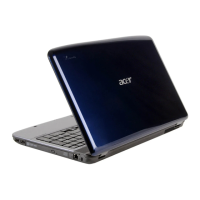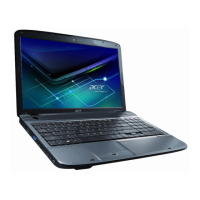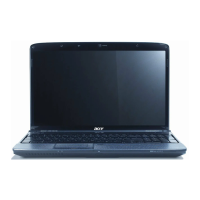
Do you have a question about the Acer Aspire 5738 Series and is the answer not in the manual?
| Screen Resolution | 1366 x 768 |
|---|---|
| Memory Type | DDR2 |
| Graphics | Intel GMA 4500MHD |
| Operating System | Windows Vista or Windows 7 |
| Battery | 6-cell Lithium Ion |
| Battery Life | Up to 3 hours |
| Weight | 2.7 kg |
| Display | 15.6 inches |
| RAM | 4 GB |
| Storage | 320 GB HDD |
| Optical Drive | DVD Super Multi |
| Chipset | Intel GM45 Express |
| Wireless | Wi-Fi 802.11b/g/n |
| Ports | 3 x USB 2.0, 1 x HDMI, 1 x VGA, 1 x Ethernet, 1 x Headphone, 1 x Microphone |
| Processor | Intel Core 2 Duo |
Summary of computer features, including platform and system memory details.
Details on screen resolution, aspect ratio, and graphics controllers.
Information on hard disk drive and optical drive options.
Details on keyboard and touchpad.
Features of the audio system, including speakers and microphone.
Information on Wi-Fi, Bluetooth, and WWAN capabilities.
List of input/output ports and their functions.
Operating and storage conditions for temperature and humidity.
Physical dimensions and weight of the notebook.
Identifies external components visible from the front.
Identifies external components visible from the closed front.
Identifies external components visible from the left side.
Identifies external components visible from the right side.
Identifies external components visible from the rear.
Identifies external components visible from the bottom.
Explains the function of the quick-access buttons above the keyboard.
Details how to use the touchpad and its buttons.
Describes the function of Caps Lock, Num Lock, and the numeric keypad.
Explains Windows-specific keyboard shortcuts.
Explains keyboard shortcuts for system controls like brightness and volume.
Details special keys like Euro symbol and dollar sign.
Explains how to use Acer GridVista for multi-display management.
Details CPU types, core logic, and package specifications.
Provides details on memory controller, size, sockets, and combinations.
Information about LAN chipset, protocol, connector, and features.
Details Bluetooth chipset, data throughput, protocol, and interface.
Information on wireless module chipsets and data throughput.
Specifications for various hard disk drive vendors and models.
Details optical drive vendors, performance, and applicable disc formats.
Information on Blu-ray drives, including loading mechanism and input voltage.
Details on audio controller, onboard options, resolution, and sampling rate.
Information on video chipset and memory size.
Specifications for USB chipset, compliancy, and port count.
Lists major chipsets on the system board.
Details about the keyboard controller and key count.
Information on battery vendor, type, capacity, and cell count.
Specifications for the 15.6-inch LCD display.
Details input and output specifications for the AC adapter.
Explains ACPI modes and power management states.
Instructions on how to navigate and use the BIOS setup menus.
Displays summary of computer hardware information in BIOS.
Allows setting system time, date, and boot options.
Contains parameters for safeguarding the computer from unauthorized use.
Step-by-step guide to setting user or supervisor passwords.
Instructions on how to remove existing BIOS passwords.
Steps to change an existing BIOS password.
Allows user to decide the order of boot devices.
Confirms or discards changes made in BIOS Setup Utility.
Lists the necessary tools for disassembling the computer.
Provides important notes before starting disassembly.
Lists actions to take before disassembling the notebook.
Outlines the stages of disassembly: external, main unit, and LCD module.
Visual representation of the external module disassembly sequence.
Step-by-step instructions for removing the battery pack.
Procedure for removing the SD dummy card.
Instructions for removing the DIMM memory module.
Steps to remove the back cover of the notebook.
Procedure for removing the hard disk drive module.
Instructions for removing the wireless LAN modules.
Steps to remove the optical drive module.
Illustrates the sequence for disassembling the main unit components.
Procedure for removing the middle cover.
Steps to remove the keyboard.
Procedure for removing the LCD module.
Instructions for removing the USB board module.
Procedure for removing the modem module.
Instructions for removing the Bluetooth module.
Procedure for removing fingerprint and touchpad boards.
Instructions for removing the left speaker module.
Procedure for removing the main board.
Instructions for removing the heatsink module.
Procedure for removing the CPU.
Visual representation of the LCD module disassembly sequence.
Procedure for removing the LCD bezel.
Instructions for removing the inverter board, specific to certain models.
Procedure for removing the LCD panel along with its brackets.
Steps to remove the LCD brackets.
Procedure for removing the Flexible Printed Circuit (FPC) cable.
Instructions for removing the wireless antennas.
Procedure for removing the web camera module.
Guidelines for checking system components like diskette, CD-ROM, and keyboard.
Procedures for verifying memory installation and detecting errors.
Steps to verify power supply issues with the adapter and battery.
Steps to resolve issues with the touchpad not working correctly.
Index of POST error messages and their potential causes.
Lists error codes, messages, and their causes.
Table of beep codes and their corresponding POST routine descriptions.
Cross-references symptoms with FRU actions for troubleshooting.
Troubleshooting steps for power management issues like hibernation and standby.
Troubleshooting for external devices, USB, and ports.
Troubleshooting steps for keyboard and touchpad issues.
Troubleshooting for internal modem problems.
Guidance on diagnosing and resolving intermittent system hang issues.
Procedures for isolating failing FRUs when the cause is not clear.
Identifies connectors on the top view of the main board.
Identifies connectors on the bottom view of the main board.
Procedures for clearing BIOS passwords via hardware gap.
Detailed steps to bypass or clear BIOS passwords.
Procedures for recovering BIOS using a crisis disk.
Instructions for creating a crisis disk for BIOS recovery.
Illustrates the exploded view of the computer's components.
Lists all field-replaceable units with part names and numbers.
Detailed specifications for Aspire 5738 Series models.
Detailed specifications for Aspire 5536 Series models.
Detailed specifications for Aspire 5542 Series models.
Lists hardware tested for compatibility with Windows OS.
Lists compatible PCMCIA cards, LAN, Modem, ISDN, and GPRS cards.
Lists compatible ExpressCard devices.
Lists compatible memory cards.












